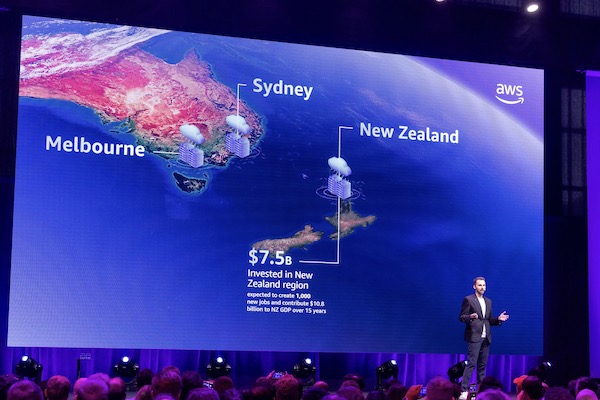Published on the 08/08/2025 | Written by Heather Wright

Do data centre claims really stack up?…
As AWS again releases gushing press releases about its $7.5 billion Auckland data centre plans – this time accompanied by news that ‘we have trained more than 50,000 Kiwi [sic] already’ – how realistic are the figures?
Last week the company announced the signing of Kiwibank, Mattr and Deloitte to the new AWS region. This week it was New Zealand Rugby that was the new signee. And as with other releases, AWS took the opportunity to remind everyone that its’ is investing NZ$7.5 billion to build the region in Auckland, and it’s expected to contribute NZ$10.8 billion to the national GDP over 15 years. (Those figures haven’t changed since AWS first announced the facility back in 2021.)
iStart’s requests for interviews with AWS to discuss the figures were declined.
“The most concerning is that they tend to massively overstate macro-economic benefits at a national or regional level.”
AWS has been equally bolshy about its Australian spend: earlier this year it announced it was ‘investing’ AU$20 billion to expand data centre infrastructure by 2029, investing in three new solar farms and digital skills training.
Sam Higgins, Forrester VP, principal analyst, says economic impact studies like AWS’ have become ‘as common as cloud services these days’.
He’s sceptical about their worth noting that while they offer a useful baseline, the fact is they are never validated after the fact by the hyperscalers – or by the politicians photographed shaking hands with the fly-in CEO or local managing director.
“Our economic dreams simply won’t come true just because a US or Chinese hyperscaler has already decided to open another energy hungry data centre on either the North or South Island,” Higgins says.
“Sadly, these headline GDP claims often become rallying cries for market share rather than anything designed to prove the delivery of real or measurable outcomes. At most we can expect that Stats NZ might see some minor capital formation on construction finding its way into the national accounts but beyond that it’s unmeasurable potential.”
The facility, originally touted to open in 2024 and now expected – at least by AWS – to open in 2025, is mired in secrecy with AWS declining to provide specifics. Earlier this year drainage issues on the site were blamed for construction reportedly being halted at the site in June this year.
What is known is that AWS has purchased three adjoining properties in Fred Taylor Drive in Auckland. It was granted permission by the Overseas Investment Office in March 2022 to purchase property to establish a cluster of three data centres in Auckland with a consideration of between $250 million and $350 million. That was followed in December 2024 by permission to acquire 0.2 hectares of residential land on Fred Taylor Drive for a consideration of $5.5 million to establish stormwater drainage infrastructure to enable the construction of the data centre facility on the adjoining land.
All up the land totals nearly 41,800m2.
To put AWS’ spend in perspective, consider other Kiwi data centres.
Canberra Data Centres has two hyperscale data centres in Auckland in late 2022. Dubbed New Zealand’s ‘first ever hyperscale data centres, the Silverdale and Hobsonville campuses were initially rated at 14 megawatts each, though both are now operating at 22 megawatts capacity. The initial investment? ‘More than $300 million,’ according to CDC.
Datagrid, which is reportedly still planning to open the first phase of its Makarewa data centre by 2028 – which is still awaiting resource consent – has a $2 billion price tag. Initially put at $700 million, the project includes new submarine cable connecting Makarewa with Australia’s east coast, with the data centre build initially expected to cost NZ$530 million and the cable a further $170 million.
The Datagrid project now covers 121 acres with a planned 240 megawatt in phase one, growing to up to one gigawatt ‘over time’ according to Rémi Galasso, Datagrid’s founder and executive chairman who also established the Hawaiki cable.
Microsoft, which launched its hyperscale cloud region at Westgate last December, said it would create around 50 new FTE jobs once the data centre was operational, with 300 temporary FTE roles during construction.
It’s been more coy on how much its region has cost, preferring instead to tout figures from a report into public cloud services figures which claim cloud delivery will add NZ$21 billion to New Zealand’s economy by 2026 and generate 134,000 new jobs ‘as a result of new capabilities and growth’.
It received OIO consent to buy land in Auckland for more than $100 million in 2020 and in 2022 did a deal with Contact Energy, paying the company $300 million to support building the Te Huka geothermal field so Microsoft can claim its data centre is powered entirely by renewable energy.
Earlier this year, Ian Rogers, managing director of Team IM New Zealand, told iStart most new data centre builds in Australia and New Zealand – granted, not hyperscalers or cloud regions – are in the range of 15-25 megawatts and come with a price tag of around $250million to $500 million.
Meanwhile, earlier this year a JLL Research report on economic drivers for commercial real estate in Australia noted that Australia’s data centre deployable capacity will more than double from 1350 megawatts in 2024 to 3100 megawatts come 2030 – growth that would require an estimated investment of AU$26 billion.
Higgins, who has experience building facility for the gas sector 10 years ago, says the numbers being bandied about seem big and likens claims to Russian Matryoshka dolls – companies roll up every possible aspect into the figures.
“They’ve always felt over-inflated.
“Infrastructure costs a lot of money, but you can’t tell me Amazon is paying sticker price for a server.
“The thought that they are going to inject $7.5 billion in tin and then generate $10 billion over 15 years, isn’t really a great return, is it?”
It’s big spend in a market where public cloud spend for the entire market is expected to reach $9.6 billion by 2028 – up from $5 billion in 2024 – according to Spark NZ figures.
On the economic impact – claims of $10.8 billion contribution to New Zealand’s GDP over 15 years (which 15 aren’t specified) – Higgins says at the heart of the problem with such studies are issues associated with input-output models generally.
“The most concerning is that they tend to massively overstate macro-economic benefits at a national or regional level.”
Some academic reviews have suggested overestimations can be as much as 30 to 60 percent, particularly if the studies in question count ‘indirect benefits’ like worker spending, potential employability, labour demand or local supplier activity covering everything from the concrete factory to the local chippy.
“They fail to clearly separate what’s truly new economic activity from what would have happened anyway,” he says.
The models also assume ideal economic conditions, fixed relationships and unlimited supply capacity.
“In the current geopolitical and geo-economic climate I’d say ‘ideal’ is not something we can rely on,” Higgins notes.
More robust approaches and modelling methods do exist, he says, but they’re often too complex, opaque and slow-moving for infrastructure planning – or the high impact public relations big tech companies are seeking.
“What’s needed is a middle ground and models that blend financial realism with macro insight.”
Training the masses and jobs for all
There are also big claims being made on the training side.
As part of a Memorandum of Understanding with the New Zealand government, AWS agreed to ‘provide cloud training opportunities for 100,000 people in New Zealand in the next five years’.
This week’s announcement saw Amazon Web Services New Zealand country manager Manuel Bohnet saying he was pleased to announce that ‘we have trained more than 50,000 Kiwi already’.
There’s no word however on whether those are net-new learners, whether the training is certified, whether it has actually be completed or just started.
Those in the industry spoken to by iStart applauded any efforts to raise New Zealand’s digital skills but admitted being completely in the dark about the work Amazon has been doing in the area.
AWS says it’s investing in cloud training opportunities through its AWS Academy, Skills Builder, Educate and re/Start programs.
Higgins suggests it’s likely AWS is counting anyone in New Zealand who has registered in one of the programs or been given free courses.
“Are we talking certified? Not certified? It’s all a bit rubbery,” he says.
“Whenever I have asked anybody in the tech ecosystem – so this is not just a criticism of AWS – what they mean by training, they normally count the people they have given free courses away to.
“My boys, when they were in their teenage years used to sign up for all sorts of software development courses and muck around online.”
Indeed, AWS Skills Builder provides hundreds of free on-demand cloud courses online. (Let’s be clear here though, that here at iStart we do applaud any upskilling.)
“The better way would perhaps be to say we didn’t train 50,000, we skilled 50,000 people in AWS technology. That would be a more accurate description of what has happened.”
AWS has also previously claimed its new region will create 1,000 new jobs. That’s a figure likely to be almost exclusively made up of those involved in building the data centres.
Today’s data centres are the dark factories of the modern era with minimal direct human involvement.
“Kiwi organisations evaluating these investments shouldn’t rely solely on sweeping economic claims or fall for the line that by jumping into a new onshore cloud that you’re automatically contributing to some imagined national good,” Higgins says.
“Instead, assess the value based on your own cost structures, workloads, and strategic priorities. By all means, make it a total economic impact, but serving you and your needs. Just like these macro-economic studies serve the branding and demand generation needs of the companies that sponsor them.”



























